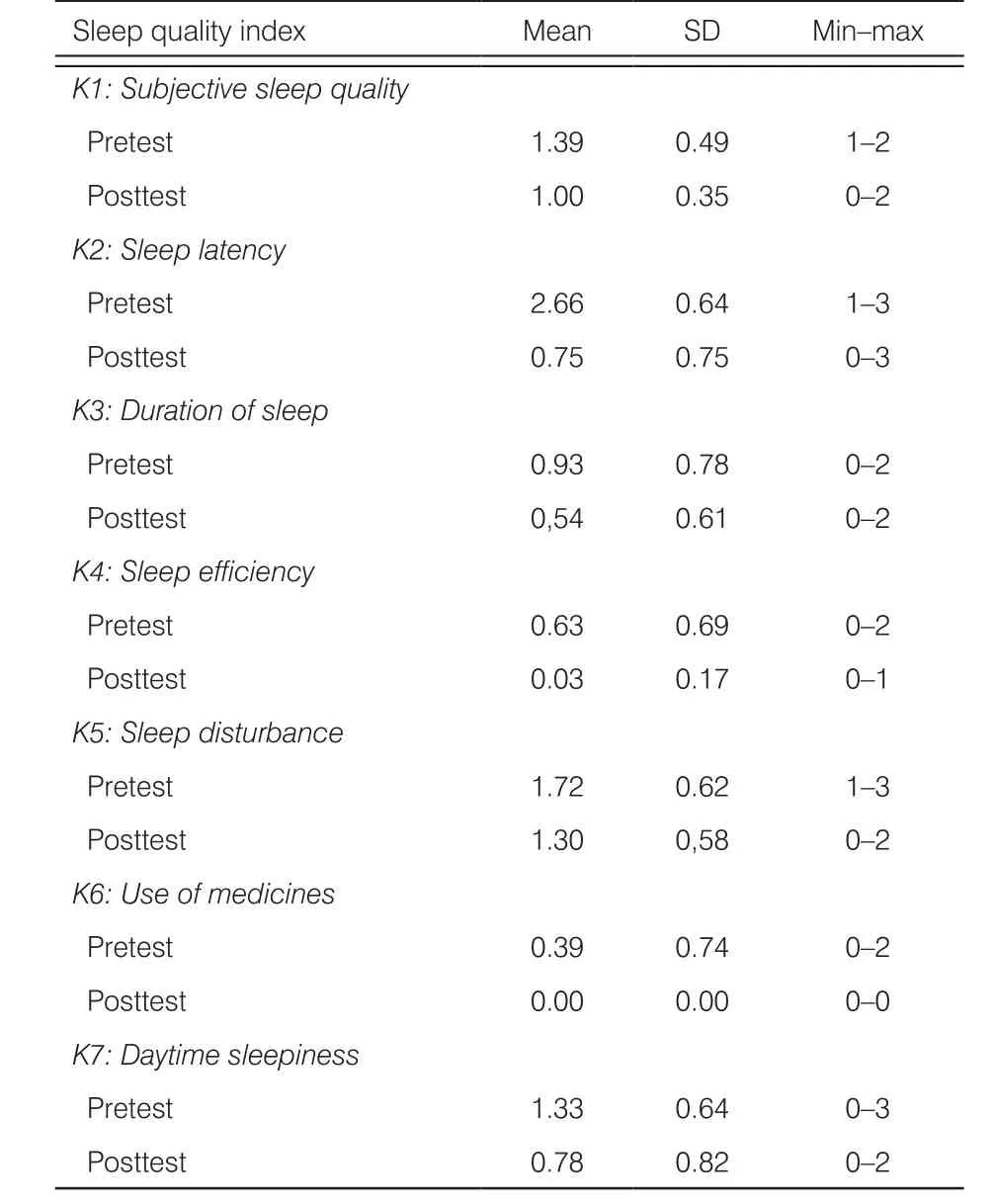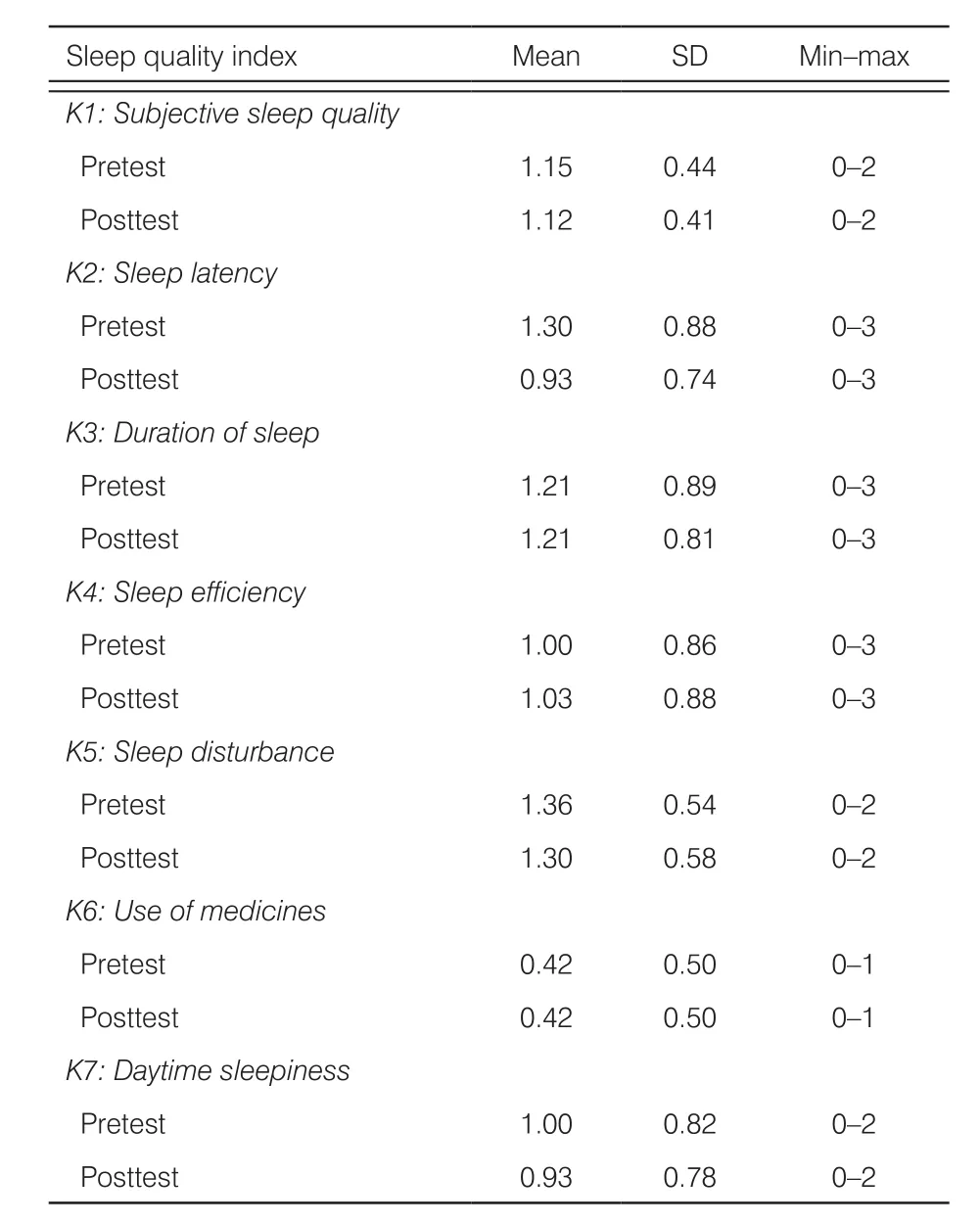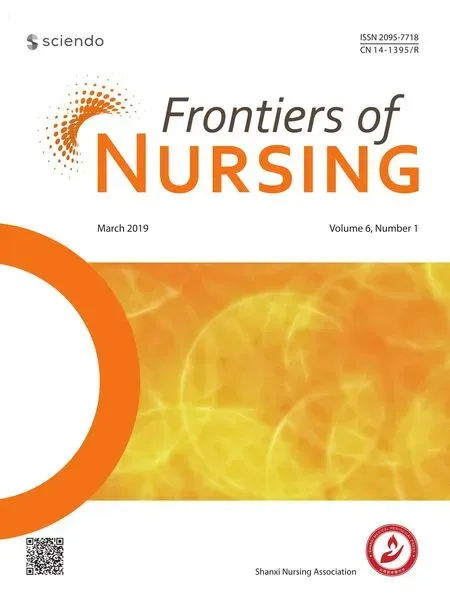Effect of hydrotherapy on sleep deficiency among older people in integrated community health services in Pandak I Bantul†
Agus Warseno, Anastasia Suci Sukmawati
aDepartment of Community Health Nursing, Nursing Faculty, Stikes Jenderal Achmad Yani, Yogyakarta 55294, Indonesia
bDepartment of Geriatric Health Nursing, Nursing Faculty, Stikes Jenderal Achmad Yani, Yogyakarta 55294, Indonesia
Abstract: Objective: Relaxation technique is a nonpharmacological treatment applied to increase sleep efficiency and the quality of sleep.Hydrotherapy is one of the relaxation techniques and uses warm water to decrease stress and muscle stiffness, as well as to warm the body. The incidence of sleep deficiency among older people in Integrated Community Health Services, Pandak I Bantul, has slightly increased year by year. This research aims to evaluate the effect of hydrotherapy on sleep deprivation among older people.Methods: The research was a quasi-experimental study with a pre-post test design. Purposive sampling was used to enroll 66 older people from the Integrated Community Health Services, Pandak I Bantul, Yogyakarta, Indonesia, as a sample, and we divided them into two groups: 33 people formed the intervention group, and 33 people comprised the control group. The intervention group did hydrotherapy once a day for a total of 7 days. First, they soaked their feet in warm water for 10 minutes. The water temperature was adjusted according to the body temperature, to approximately 40.0°C-43.0°C. Then, the intervention group took a bath using warm water. The level of sleep quality was measured using the Pittsburgh Sleep Quality Index (PSQI) questionnaire. Data analysis was done using the Wilcoxon test.Results: The mean score for sleep quality in the pretest in the intervention group was 9.04 (standard deviation [SD]: 2.57) and the score on the posttest was 42 (SD: 1.43). The mean score for sleep quality in the intervention group was 4.67, with P=0.05.Meanwhile, the research found that the difference between the pretest and posttest scores for quality of sleep in the control group was 0.42, with P=0.059. Wilcoxon analysis found that in the intervention group, there was a significant difference after intervention using hydrotherapy, with P<0.05. In the control group, there was no significance difference between the pretest and posttest scores,with P>0.05.Conclusions: According to the results of the present study, it appears that the practice of hydrotherapy is effective in reducing sleep deficiency and hence can be considered an effective method of intervention.
Keywords: hydrotherapy · sleep deficiency · older people · nursing · nursing research literature© Shanxi Medical Periodical Press.
1. Introduction
The proportion of aging population is increasing rapidly year by year, and the deep influence of this phenomenon on the economic and social conditions has been studied using multilateral approaches, such as social, physical, and psychological aspects. Data from the Central Bureau of Statistics show that the number of aged persons in Yogyakarta has increased from 492,200 in 2015 to 505,100 in 2016.1Changes in the sleep pattern are experienced by older people.Bundlie2states that there are age-related changes in sleep, namely, increased sleep latency, reduced sleep efficiency, increased nocturnal awakening, increased early morning awakening, and increased daytime sleepiness. Sleep quality is essential for older people's well-being and health. Sleep quality in older people can be influenced by environment, pain,3lifestyle,3diet,4psychological condition,4treatment, and cognitive disorders.2,5
Relaxation technique is a nonpharmacological treatment that is applied to increase sleep efficiency and improve the quality of sleep. Hydrotherapy, a relaxation technique that uses warm water, can decrease stress,6muscle stiffness,2,5and pain, in addition to warming the body.7,5,8The prevalence of sleep deprivation among older people in the Integrated Community Health Center, Pandak I Bantul, was found to slightly increase year by year. There is no previous study on water treatment for older people with sleep disorder in Bantul, Yogyakarta, Indonesia. This research aims to evaluate the effect of hydrotherapy on sleep deprivation among older people in the Integrated Community Health Center, Pandak I Bantul, Yogyakarta, Indonesia.
2. Methods
2.1. Protocol and registration
The research was conducted at the Integrated Community Health Center, Pandak I Bantul, Yogyakarta.The subjects were 66 older people with sleep disorder.The quality of sleep was measured using the Pittsburgh Sleep Quality Index (PSQI). The PSQI questionnaire was modified by Herlina.4The PQSI modi fi cation had validity and reliability. The r score was 0.528-0.934, and Cronbach's alpha score was 0.889.7The PSQI contains 15 questions with seven dimensions: subjective sleep quality, sleep latency, duration of sleep, sleep efficiency,sleep disturbance, use of medicines, and daytime sleepiness. Respondents were divided into an intervention group receiving hydrotherapy and a control group receiving no treatment; 33 people were included in each group.
2.2. Procedure
After choosing the intervention group, the PSQI questionnaire was administered to the participants. The intervention group did hydrotherapy once a day for a total of 7 days. First, they soaked their feet in warm water for 10 minutes. The water temperature was adjusted according to the body temperature, to approximately 40.0°C-43.0°C. Then, they took a bath with warm water.The hydrotherapy was performed in the afternoonfor all patients. After 7 days of hydrotherapy, the questionnaires were given again to the participants. The lowest score in this questionnaire is zero and the highest score is 21. A score of zero shows better sleep quality, and the number 21 shows the worst quality of sleep. The quality of sleep is categorized as good if the PSQI score is ≤5 and as poor if the PSQI score is >5. The control group did not receive hydrotherapy but participated in regular activities.
2.3. Statistical analysis
Wilcoxon analysis was used to determine the difference between the intervention and control groups in terms of the effect of hydrotherapy treatment.9
3. Results
The data showed that the difference between the pretest and posttest scores for quality of sleep in the control group (0.42) with P = 0.059, which showed no significance. In addition, the research found that the mean pretest score for sleep quality in the intervention group was as high as 9.09 (SD: 2.57) and the posttest score was 4.42 (SD: 1.43). The mean score of the difference in sleep quality in the intervention group was 4.67. There was a significant difference in sleep quality before and after intervention using hydrotherapy, with P < 0.05.
Table 1 shows that before intervention, the respondents in the intervention group had poor sleep quality,with mean score = 9.09. After intervention, the mean score was 4.42. Meanwhile, the control group shows mean sleep quality scores as follows: pretest score was 7.51, and posttest score was 7.09.

Table 1. Pretest and posttest sleep quality indexes in the intervention and control groups (n=33).

Table 2. Sleep quality in the intervention group (n=33).

Table 3. Sleep quality in the control group (n=33).

Table 4. The effect of hydrotherapy on sleep quality in theintervention and control groups (pre-post test design) (n=33).
Data in Table 2 show that the mean score for each component of sleep quality index in the intervention group was decreased after hydrotherapy treatment(posttest result).
The most noticeable change noted in Table 2 is that the use of medicines by the elderly in the intervention group decreased extremely, from a mean score of 0.39 to mean score of 0.00 (Table 3).
Table 4 shows a significant result in the intervention group, with P = 0.000 (P<0.05). The mean score for sleep quality index on the pretest was 9.09 (SD: 2.57),while the posttest mean score was 4.42 (SD: 1.43), with difference in the score being as high as 4.67. The difference between the pretest and posttest scores in the control group was 0.42. However, it showed no significant difference (P=0.059).
4. Discussion
Hydrotherapy is the external or internal use of water,in the form of ice or warm water, at various temperatures and pressures, for various durations, and applied at different sites, for promotion of health or for treatment of various diseases.5Hydrotherapy can improve blood circulation by expanding blood vessels. Analysis of the components of sleep quality in the intervention group shows significant difference before and after intervention: subjective sleep quality, sleep latency,sleep duration, sleep efficiency, sleep disturbance,use of medicines, and daytime sleepiness. Hydrotherapy affects the level of serotonin hormone and makes people more relaxed, reducing the sleep deprivation of people as a result.5From the data, it was found that the sleep disorder decreased after hydrotherapy. Low score of sleep quality is an indicator of good sleep quality; therefore, the data obtained from the present study show that hydrotherapy can increase the quality of sleep among older people.
According to the findings of the present study, there is a significant difference in the sleep quality among older people before and after the intervention using hydrotherapy. It shows that hydrotherapy treatment is effective in reducing sleep deficiency among older people. A previous study also found that the quality of life was increased and the depression level was decreased among elderly women who received hydrotherapy treatment.10Another study also found that sleep quality was increased after hydrotherapy intervention (indoor warm pool) among older people with fi bromyalgia (P=0.0001).8
Overall, the results of the study show that hydrotherapy is effective in reduction of sleep deficiency.Therefore, hydrotherapy treatment is recommended because it is effective in reducing sleep disorders among the elderly.
5. Conclusions
According to the results of the present study, it appears that the hydrotherapy practice is effective in reduction of sleep disorders among older people and can be considered as an effective intervention method. Further studies are required to find the mechanism of hydrotherapy and its use in other conditions, using larger sample sizes.
Acknowledgments
The authors wish to thank the elderly in the community who participated in this study. The authors would like to express gratitude to all who have given generously of their time to edit this paper.
Conflicts of interest
All contributing authors declare no conflicts of interest.This research received no grant from any funding agency in the public, commercial, or not-for-profit sectors.
- Frontiers of Nursing的其它文章
- Correlation between intakes of carbohydrates, protein, and fat with random blood sugar levels in menopausal women
- Advancing the quality of care and nursing practice through emancipatory reflection
- Frontiers of Nursing Call for Papers
- Empty-nest elderly: mahjong and Chinese square dance for improving the cognitive function in the community
- Self-esteem enhancement as a strategy for promoting the mental health and averting the occupational problems of nurses
- A critical reflection on the discipline of nursing based on the correct analysis of the relationship between medicine and nursing†

